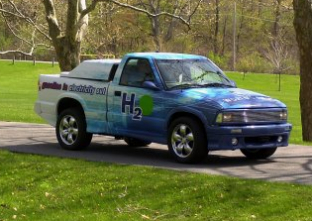
This Week:
-
GM Demonstrates World's First
Gasoline-Fed Fuel Cell Vehicle
. -
DaimlerChrysler, Hyundai, and
Mitsubishi Motors to Form Global Engine Alliance
. -
Ford Adds Escape Production At
Ohio Assembly Plant
. -
Covisint Increases
Pan-European Presence
. -
Toyota Motor Sales U.S.A.
Announces Organizational Changes
. -
International Success of MINI
Signals - Further Investment and Employment for the UK Motor Industry
. . - PSA Peugeot CitroŽn and
Electricitť de France to Work Jointly on the Development of Electric
and Hybrid vehicles
. -
Aston Martin Jaguar Land Rover
Canada Posts Increased Sales For April
. -
Magna announces redemption of
4.875% convertible debentures due 2005
. -
Opel Vivaro As "Combi"
People Carrier And Long-Wheelbase Panel Van
.
© 1998
- 2002 Copyright &
Disclaimer
Automotive Intelligence,
www.autointell.com
All Rights Reserved .
For questions please contact
editor@autointell.com

News of May 08, 2002
GM Demonstrates World's First Gasoline-Fed Fuel Cell Vehicle

Chevrolet S-10
Photo: GM
Technology has far-reaching potential for cars, homes and business
HONEOYE FALLS, NY. - General Motors Corp. made history by demonstrating the world's first drivable fuel cell vehicle that extracts hydrogen from gasoline to produce electricity.
"This vehicle and the reforming technology in it move us closer to a hydrogen economy," said Larry Burns, GM's Vice President of Research and Development, and Planning. "This is a drivable lab that is helping us to learn to reform fuels for fuel cells to power cars, homes and businesses. A lot of people said we couldn't use gasoline to power a fuel cell system. Well, we did it."
The Chevrolet S-10 fuel cell pickup is equipped with a fuel processor that reforms low-sulfur gasoline onboard by a series of chemical reactions. The fuel is mixed with air and water, and then passed over a series of catalysts that break apart - or "crack" - the hydrogen from the carbon. The resulting stream of hydrogen is sent to the fuel cell stack, where it is combined with oxygen from the air to produce electricity.
When linked with a fuel cell stack, the reformer technology in the vehicle could achieve up to 40 percent overall energy efficiency, which is a 50 percent improvement over a conventional internal combustion engine. With a reformer fuel cell, the S-10 pickup could approach 40 mpg. Carbon dioxide emissions would be cut by up to 50 percent if the gasoline was reformed onboard and greatly reduced if the reformer were placed at the gas station. All regulated emissions would be nearly eliminated, except for trace amounts of carbon monoxide and hydrocarbons. There are no oxides of nitrogen.
The fuel cell technology in the S-10 also plays a key role in the transition to a hydrogen-based economy. GM envisions being able to have your car power your home and your home becoming a source of hydrogen for your car.
According to Burns, there will be a number of sources for creating hydrogen and the competition will help spur the use of fuel cells.
"You can reform gasoline onboard or at the gas station to produce hydrogen or you can create it at your home or business," Burns explained. "You can reform natural gas at your home or you can electrolyze water. Your home or office could become an alternative to a gas station in the future.
"In most cases, you already have natural gas, water and electricity coming into your home or place of business. To create hydrogen, all that is missing is a natural gas reformer or an electrolyzer. Bottom line, the transition will happen faster because there will be so many competing ways to refuel without replacing the existing infrastructure."
The neighborhood gas station would also evolve. By taking the reformer off the vehicle and putting it at the pump, people would refuel much the same way as they do now. The only difference is they would pull up to a pump supplying hydrogen reformed from gasoline.
"Just as the auto companies are competing on vehicle technology, we believe existing energy providers - oil companies, natural gas companies and electric utilities - as well as new start up energy companies, will compete to provide the fuel for fuel cell vehicles.
"For this reason, gasoline remains a very viable alternative, especially given the existing fuel distribution infrastructure," Burns said. "The infrastructure isn't going to go away. That asset base is simply too big to just disappear as the hydrogen economy comes about. I believe the petroleum companies will play an active role in developing the hydrogen economy. Gasoline is an efficient way to distribute hydrogen, whether the reformer is on the vehicle or in the pump."
While petroleum may prove to be the best interim solution for obtaining hydrogen, the end-goal is a world powered by hydrogen produced from a variety of feedstocks - crude oils, natural gas, coal or renewable - whatever combination proves to be the most viable.
During the next year, GM engineers will put the vehicle through rigorous testing to more clearly determine such things as range, efficiency, emissions and fuel-reforming characteristics. Burns remains confident about finding solutions to issues such as cost, hydrogen storage and supplying fuel to these fuel cell vehicles.
(May 1, 2002)
[Homepage] [
News] [ Companies] [
Management] [ Publications]
[ Events] [ Careers]
[Services] [Discussion] [
Guestbook]
[ Search]